Law Firm Marketing 101: A Step-by-Step Guide

Imagine being the most skilled lawyer in town. You boast an unbeaten record of court victories. And yet the echo of your office phone seems to have taken a permanent sabbatical.
Let’s be honest. As the world becomes increasingly digitally driven, expertise and experience alone can’t woo clients. You may be a lawyer extraordinaire, but that doesn’t guarantee a queue of clients at your door unless you’re stellar at something else too: being visible online.
Let’s think of it this way. Joe has just been handed a parking ticket that he believes is unjust. He’s furious and determined to fight his case. But wait…he needs a lawyer. Panicked, he picks up his phone, types “traffic violation lawyer near me” on Google, and clicks on the first name that pops up. If your firm isn’t that name, Joe isn’t your client. It’s that simple.
SEO (search engine optimization) is the magic cloak that can transform your law firm into a visible, loud, and clear online business. The next time a Joe or Jane is in a pickle and turns to Google for help, your business will show up first.
The benefits? More calls, more clients, more victories, and a glossy reputation as a lawyer. Sounds like a plan? We’ll help turn it into reality.
Stick around for an A-Z breakdown of law firm marketing. If you’re new to marketing for lawyers and curious about the right way to leverage SEO for your law firm, this is it. The verdict is in; are you ready to hear it?
1. Identify Your Target Audience

Let’s say you’re a great lawyer who specializes in immigration law. You deliver an impressive speech about immigration rules, visa processes, and potential legal pitfalls. The room is packed, but there’s one hitch: the audience is full of teenagers more interested in the latest TikTok trends than immigration laws.
See the problem? This is exactly what happens when you don’t know your target audience. You end up delivering excellent content to the wrong people. While this may sound like something that rarely happens, it’s actually pretty common in the legal industry. When lawyers jump straight into SEO and skip this step, they end up targeting the wrong people who fail to convert. The outcome? Your legal marketing efforts will go down the drain.
While this is frustrating for legal businesses in general, it’s especially unnerving for small businesses just dipping their toes in the small law firm marketing waters. You’ll end up losing revenue and thinking SEO is just a silly waste of time. It’s not, provided you kick things off on the right note, i.e., identifying your target audience. This is a great way to ensure that your message reaches the right people at the right time in the right way. How should you go about this? Let’s break it down.
What is a Target Audience?
A target audience is a specific group of individuals interested in your products/services. In this case, it’s the group of people who would potentially require legal services from your law firm.
It’s important to note that your target audience isn’t “everyone.” While it’s true that, theoretically, anyone may need legal services at some point, marketing to such a broad audience is both inefficient and ineffective.
Your target audience isn’t static. It can change and evolve over time depending on various factors like changing laws, demographics, and the competitive landscape. Identifying your target audience isn’t a one-time exercise but rather an ongoing process that requires periodic reassessment and adjustment.
How to Identify Your Target Audience in 5 Steps
Step 1: Analyze Your Current Clients
Start with what you know. Look at your existing client base and pick up on common characteristics and trends.
- What type of clients tend to seek your services?
- Individuals or businesses?
- What kind of legal issues do they have?
- Any common demographic traits like age, location, occupation, or income level?
Understanding your current clients can provide valuable insights into who your target audience should be.
Step 2: Define Your Niche
Every law firm has areas of expertise or specialty services that set it apart from the competition. Maybe you excel at criminal law. Or perhaps your strength lies in family law. Defining your niche will help you identify the types of clients who need your services most.
Step 3: Understand the Market Needs
Conduct market research to develop a good grasp of potential clients’ needs and pain points. Use surveys, interviews, or focus groups to collect data. This can help you identify gaps in the market that your law firm can fill.
Step 4: Study Your Competitors
Look at other law firms in your area. Who are they targeting? What types of clients do they have? This can give you ideas for potential target audience segments you may have overlooked.
Step 5: Create Client Personas
Based on your analysis, create client personas, i.e., fictional representations of your ideal clients. These personas should include demographic information and details about their behavior patterns, motivations, and goals. They can guide your marketing efforts and help you tailor your message to the right audience.
Use Target Audience Insights to Your Advantage
Once you’ve identified your target audience, it’s time to put that information to good use. Tailor your marketing strategies to your target audience’s unique needs and preferences.
Let’s say your target audience largely comprises businesses that require legal help with contract law. In this case, you could create content about common contract pitfalls, what to look for in a legal advisor for contract law, and so on.
On the other hand, if your target audience comprises individuals who require family law services, you could create blogs about navigating divorce or child custody issues, share success stories that demonstrate your expertise in family law, and the like.
Understanding your target audience will also guide your decisions about where to concentrate your marketing efforts. For instance, if your target audience is younger, they’re likely to be active on social media platforms. Focusing your marketing efforts there could yield better results.
Identifying your target audience is only the first step. What you end up doing with that information will ultimately determine the success of your legal marketing efforts.
If you fail to check this box off the list, your law firm marketing plan will be haphazard; it’ll lack direction. A good grasp of your audience will help you tailor your marketing efforts accordingly. Instead of shooting in the dark, you’ll end up taking well-aimed shots that actually propel your business forward, not create the illusion of growth.
2. Understand Your Competition

Imagine a game of chess. Each move is calculated, every piece is significant, and the opponent’s tactics are closely scrutinized. It’s not just about moving your pieces across the board; it’s about anticipating, strategizing, and staying two steps ahead.
That’s a lot like understanding your competition in the legal landscape.
It may sound paradoxical, but knowing your rivals can help you stand out. Studying your competitors helps you identify market gaps, understand industry trends, and, most importantly, differentiate your law firm.
Before we delve into the how-tos, let’s clear the air about competitor analysis. It’s not about duplicating your competitor’s strategies or losing your firm’s identity. On the contrary, it’s about gleaning insights to help carve out your unique space in the market.
Here’s a step-by-step guide to understanding your competition:
Step 1: Identify Your Competitors
Start by putting together a list of your competitors. They can be direct competitors (firms that offer similar services to similar clients) or indirect competitors (firms that target your potential clients with different services). Include local, regional, and national firms venturing out into your area.
Step 2: Analyze Their Online Presence
Check out your competitors’ websites and social media platforms. How are they presenting themselves online? What kind of content are they producing? How are they engaging with their audience?
Step 3: Evaluate Their SEO Performance
Use SEO tools to assess your competitors’ digital performance. Which keywords are they ranking for? What is their site’s architecture like? How are they leveraging backlinks? If you’re starting off with small law firm marketing, chances are you won’t have access to the right tools. Work with an experienced marketing agency for lawyers to evaluate your SEO performance like a seasoned pro.
Step 4: Review Their Client Interactions
Online reviews and testimonials provide insights into a firm’s client relationships. Are there recurring praises or complaints?
Step 5: Understand Their Marketing Strategies
Are they using paid ads, content marketing, email marketing, or other specific strategies? Are they organizing or participating in events?
Step 6: Assess Their Service Offerings
Which services do they provide? How are they priced? Which additional benefits do they offer, e.g., free consultation, after-hour services, etc.?
Collecting this information may feel like detective work, but remember, it’s not about copying your competitors’ strategies but learning from them.
Once you’ve analyzed your competition, use this information to your advantage. Identify your firm’s strengths and unique offerings, work on areas where you lag behind, and identify potential growth opportunities.
3. Set a Marketing Budget

As the saying goes, “You have to spend money to make money.” But it’s not just about spending; it’s about spending wisely.
This is where setting a marketing budget comes in.
Allocating a specific budget for marketing is like defining the roadmap for your law firm’s journey towards growth. It serves as a financial framework and acts as a strategic tool that guides your decisions on which marketing avenues to pursue.
Let’s navigate the ins and outs of setting a marketing budget for your law firm.
Why is a Marketing Budget Important?
This may sound like an unnecessary step at first. Why can’t you simply dive into law firm marketing? Why should you spend a big chunk of your valuable time crafting a budget? Let’s explore the role of a robust marketing budget in detail.
Benefit 1: It Helps Prioritize Resources
The law of marketing isn’t “spray and pray.” It requires you to focus your resources on efforts that are likely to yield results.
A marketing budget is instrumental in this regard. It helps you determine which strategies and channels get the lion’s share of the resources and which ones should be relegated to a lower priority.
A budget gives you perspective on where to channel your funds: SEO, content marketing, social media marketing, traditional marketing channels, and the like.
Benefit 2: It Keeps Spending in Check
Law firm marketing is an exciting field with a myriad of opportunities. And it’s very easy to get carried away. Before you know it, your firm could be knee-deep in expenses with little to show for it.
A well-defined marketing budget acts as a necessary financial boundary. It sets a limit on how much you can spend on legal marketing activities. The outcome? Fiscal discipline and the prevention of overextension of resources.
Benefit 3: It Measures ROI
You can’t manage what you can’t measure. Assessing the return on investment (ROI) of your legal marketing activities without a budget can be challenging.
A marketing budget provides a clear cost-benefit analysis framework. By setting a budget, you earmark funds for each marketing activity. Combine it with tracking your outcomes, be it leads, conversions, or brand awareness, and you can efficiently measure your marketing ROI.
This neat little trick will end up fetching valuable insights into the effectiveness of your efforts.
Benefit 4: It Creates Accountability
A marketing budget doesn’t just deal with dollars and cents; it also deals with accountability. When you set a budget, you set expectations. You create a financial blueprint that projects the anticipated costs and expected results.
This brings a sense of responsibility. Every decision made and dollar spent can be traced back to its return. This encourages careful planning, disciplined execution, and data-driven adjustments.
Benefit 5: It Facilitates Performance Tracking
Without a marketing budget, you’re essentially operating in the dark. You may be overspending on underperforming tactics or underspending on strategies that could yield significant results.
A defined budget aids in performance tracking and gives you the ability to swiftly and effectively adjust your strategies based on real data.
How to Set a Marketing Budget
Step 1: Define Your Goals
This is the cornerstone of your marketing budget. What are your marketing objectives? Are you aiming to increase brand visibility? Enhance online presence? Generate leads? Attract new ones? Retain current ones?
Each goal requires different strategies, resources, and levels of funding. Obtaining a clear picture of your goals will give you marketing direction and help you allocate your budget wisely.
Step 2: Review Your Financial Status
Your budget should reflect your law firm’s financial health. Look at your revenue forecasts, profit margins, and cash flow. How much can you afford to allocate to marketing without jeopardizing your firm’s financial stability? Your marketing spend should be an investment, not a financial burden.
Step 3: Benchmark Industry Standards
While your firm’s unique needs and goals should primarily drive your marketing budget, industry benchmarks can provide useful guidance. Law firms typically spend between 2% and 10% of their revenue on marketing. This range can be a helpful starting point, but remember; it’s just a guide. Your firm’s specific circumstances may necessitate spending above or below this range.
Step 4: Consider Your Marketing Channels
Not all marketing channels are created equal. They have different reach, engagement rates, costs, and ROI. Some channels may be more effective than others depending on your target audience and marketing goals.
Understand the cost and potential returns of each channel, be it social media, SEO, email marketing, or PPC. This will help guide your budget allocation.
Step 5: Estimate Costs
This is where you’ll start getting into the specifics. List all potential expenses related to your marketing efforts. This could include costs for SEO tools, social media advertising, content creation, website maintenance, email marketing software, hiring a marketing agency for lawyers, and so on. Getting a handle on these costs will help you allocate your budget more accurately.
Step 6: Monitor and Adjust
A marketing budget isn’t just a static document; it should evolve with your law firm’s needs, market dynamics, and campaign performance.
Regularly track your spending and the results of your marketing efforts. This is a great way to collect insights into what’s working, what isn’t, and where you may need to reallocate funds.
Example of a Law Firm Marketing Budget
What should your marketing budget look like? There are no set rules. The numbers ultimately vary depending on factors like your firm’s size, location, practice areas, goals, and more.
However, we’ll give you a general idea of what your budget could look like. Keep in mind that these are only potential items; your firm may not need all of these or may need more based on your specific legal marketing strategy.
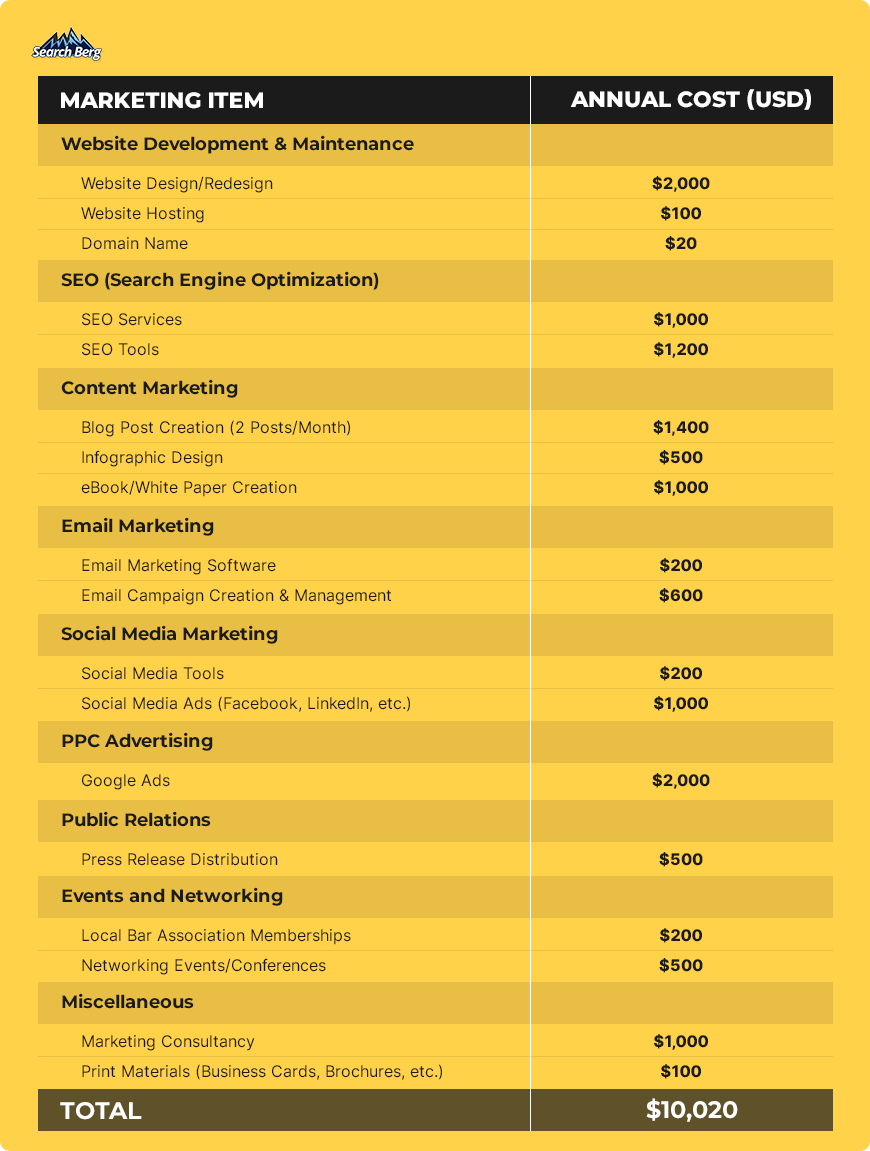
Follow our lead? Work with a legal marketing firm that can take the reins for you. They’ll set a budget based on your unique requirements and goals.
4. Optimize Your Website Using the Right SEO Strategies

In the courtroom of the digital world, your law firm’s website stands in the dock. Instead of being judged by a jury, it’s judged by search engines and web users.
The charge? Being invisible in the vast expanse of the internet. The consequence? Lost opportunities, overlooked potential, and a silent phone. And the staunch defender? Search engine optimization (SEO).
Much like a compelling closing argument always sways the court, a well-optimized website can swing the online verdict in your favor. But how do you plead your case in the eyes of Google and prospective clients? We’ll show you the way. But before we do that, let’s delve deeper into SEO and its importance for law firms.
What is SEO for Law Firms?
SEO is the strategic utilization of techniques to boost your firm’s visibility in search engine results.
When someone finds themselves embroiled in a legal tangle, their first instinct is to pull out their phone and key in “lawyer near me” or “best [specialty] lawyer in [city name].” They’re not going to sift through countless pages of results; most users stick to the first page (typically the top five listings).
When your law firm ranks on the top search engine result pages (SERPs), it goes without saying that more potential clients will find you, call you, and work with you. This is the power of SEO in a nutshell.
SEO has several components (and we’ll dive into them in just a bit). A well-crafted SEO plan is designed to make your law firm more “attractive” to search engine algorithms and provide value to potential clients who visit your website.
You’re not just pleasing Google or web users; you’re feeding both birds with one scone. This makes SEO even more powerful; it helps you check two critical boxes off the list in one go.
How Can I Optimize My Website?
Step 1: Web Design and User Experience (UX)
In the bustling digital marketplace, your law firm’s website is your digital storefront. It’s the first point of contact for many potential clients; as we all know, first impressions matter. A lot.
A well-designed website offering superior user experience (UX) can be a powerful catalyst in transforming visitors into clients.
Start by focusing on visual appeal and branding. The aesthetic design of your website should echo your firm’s professionalism and credibility. Clean lines, an uncluttered layout, and a sophisticated color palette can all contribute to creating a visually appealing digital space.
In addition, your branding elements (your firm’s logo, color scheme, typography, etc.) should be consistent across all pages to foster recognition and familiarity.
Pardalis & Nohavicka is the epitome of modern, appealing, and exquisite web design. Their website compels web users to keep scrolling and ultimately schedule a consultation, not “bounce” off the site (something that a lot of legal websites are guilty of doing).
The clean, sleek, and minimalist website is a visual treat through and through!

What’s next? User-friendly navigation. Your website should be easy to navigate and boast a clear and intuitive menu structure. Visitors should be able to effortlessly find essential pages like your practice areas, attorney profiles, contact information, client testimonials, and the like.
A well-thought-out navigation menu reduces user frustration and increases the chances of visitors exploring your website more deeply.
This brings us to mobile optimization. There are a whopping 6.8 billion smartphone users across the globe. Out of this astounding number, 50.9% of web users use their smartphones to shop online at least once a week.
If your legal website isn’t mobile-friendly, you’re leaving an enormous chunk of your audience unengaged. Your website should boast a responsive design that adapts seamlessly to different screen sizes. This little trick will help you reach a wider audience and bag more conversions.
Site speed is an essential component of web design and UX. In the fast-paced digital world, speed is king; no qualms about it. A slow-loading website can send your bounce rate soaring and negatively impact your search engine rankings. Optimize your images, use efficient coding, and consider using a content delivery network (CDN) to ensure that your site loads swiftly and smoothly.
Your website should also be accessible to all users, including those with disabilities. Accessibility features should include things like alt text for images (which also helps with SEO), keyboard navigation, and transcripts for video content.
Another critical aspect of web design and UX? Calls to action (CTAs). Each page on your website should have a clear objective and encourage users to take specific action. This could be filling out a contact form, calling your office, downloading a resource, or scheduling a consultation.
CTAs should be visually prominent and compelling in language. While CTAs benefit law firms by turning visits into conversions, they also help web users understand what to do next.
When people open legal websites in a pickle, they want action-centric information that guides them seamlessly. Clear, bold, and straightforward CTAs that encourage web users to call you, schedule a consultation, or fill out the contact form act as a big helping hand. They cut through clients’ panicked state and provide relief in the form of immediate action.
This makes CTAs all the more important for law firms. Gayle Law Group is known for its punchy CTAs in brand colors.
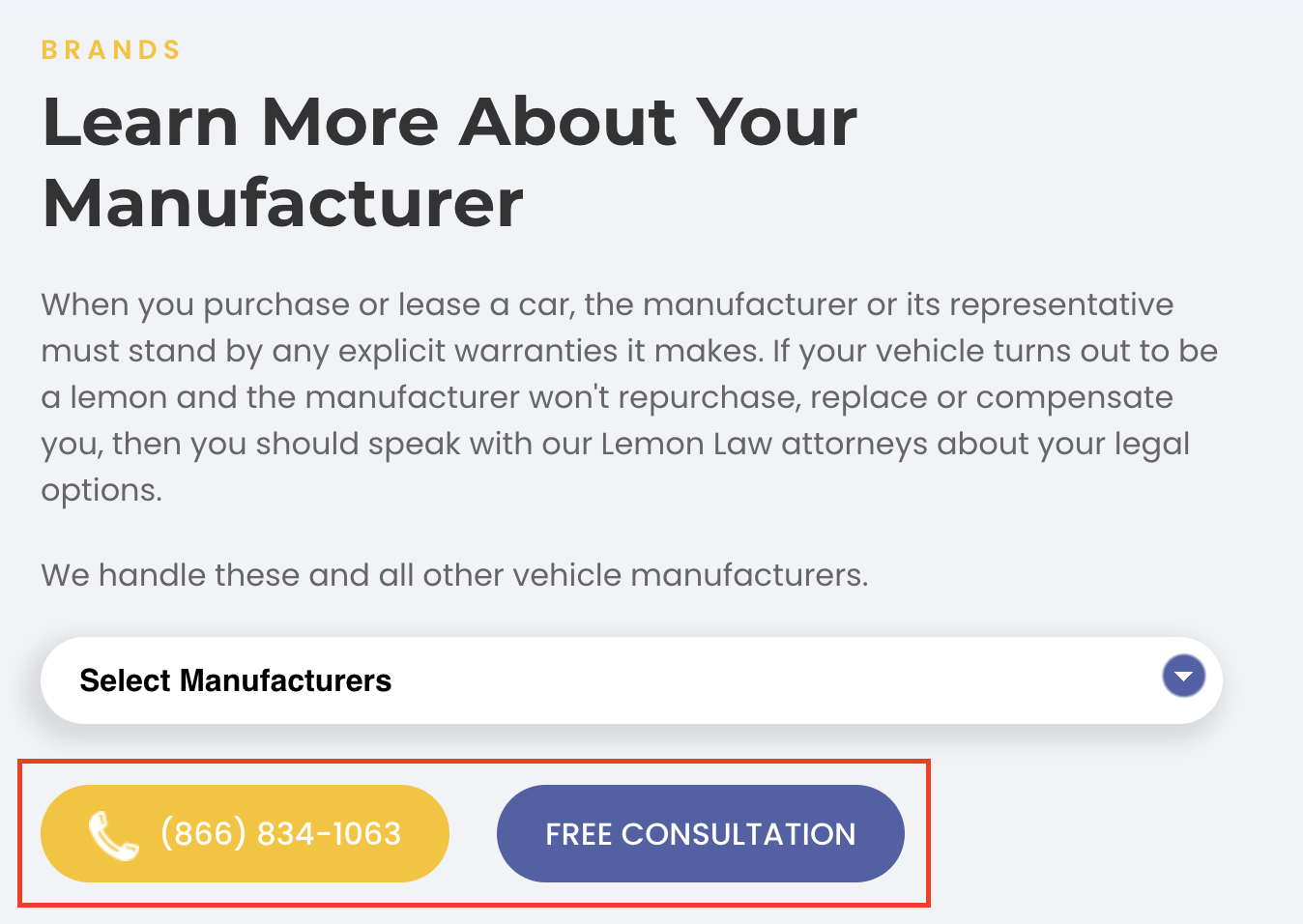
Follow their lead!
Step 2: Keyword Optimization
Keyword optimization is the process of researching, reviewing, and shortlisting the best keywords to drive qualified traffic from search engines to your website. In simpler terms, it’s about figuring out the words and phrases potential clients are punching into their keyboards or voicing on their smartphones.
Once you get your hands on these keywords and start incorporating them into your website, you’re in for enviable SERP rankings, impressive traffic, and dreamy conversions.
Keyword optimization acts as GPS; it helps potential clients find your website. When a person in need of legal assistance looks for “family law attorney in [your city]” or “how to file for bankruptcy,” and your business appears among the top search results, that’s the power of keyword optimization at work.
How can you check this box off the list? Start with keyword research. Use tools like Google Keyword Planner to identify the words and phrases your clients use when seeking legal services.
Focus on long-tail keywords, i.e., longer, more specific, less competitive phrases that can drive highly targeted traffic to your website. For instance, instead of the highly competitive keyword “divorce lawyer,” you may focus on “high-asset divorce lawyer in [your city].”
This doesn’t mean that you chuck out short-tail keywords. Instead, aim to strike the right balance between both short-tail and long-tail keywords to reach the right people.
Once you have your list of targeted keywords ready to go, it’s time to integrate them organically into your website’s content, page titles, URLs, meta descriptions, header tags, image alt text, etc.
Avoid keyword stuffing, an outdated practice that can lead to penalties from search engines. The integration should be natural and effortless; it should provide real value to your audience.
Here’s a brilliant example.
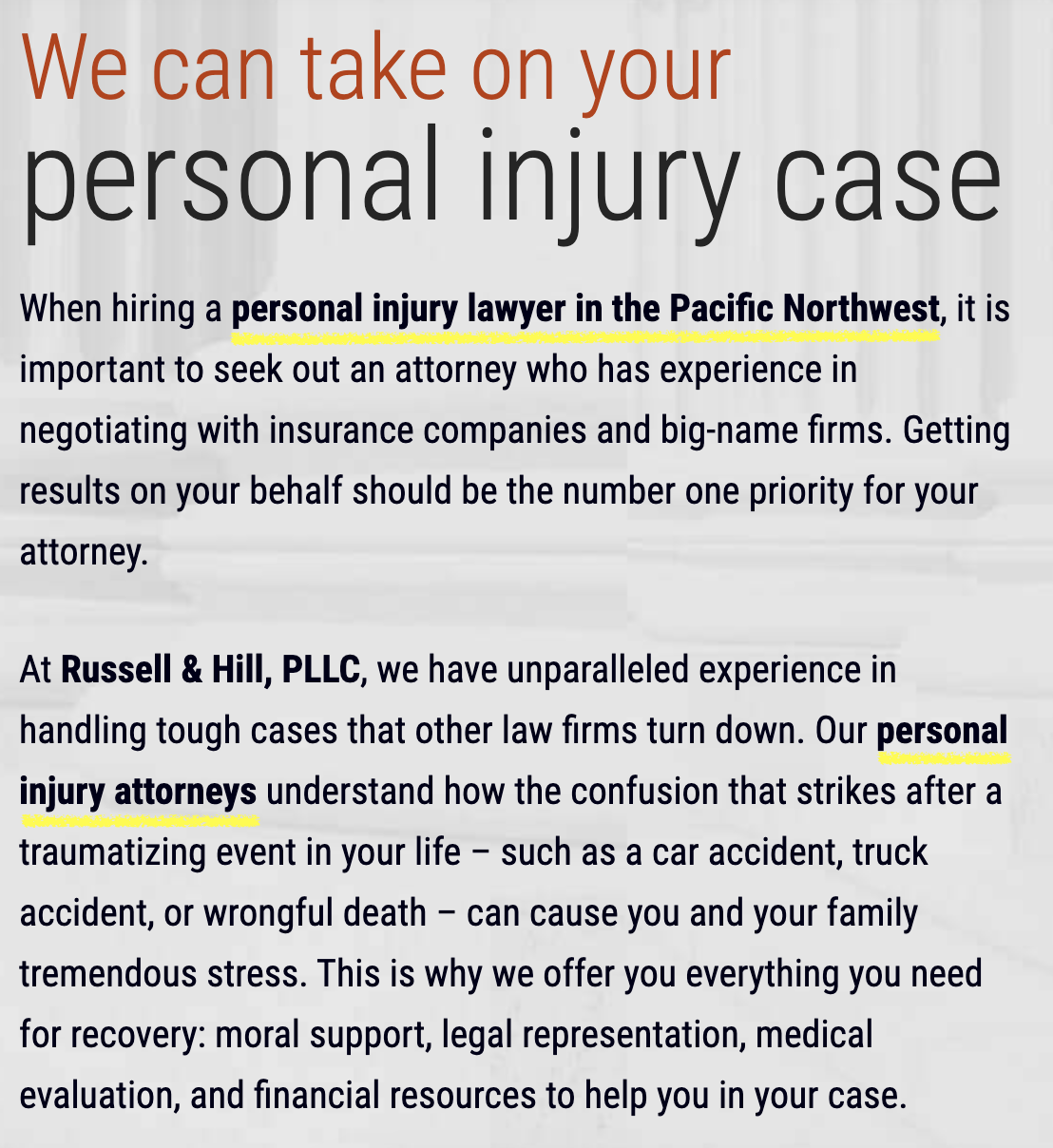
See what we mean? Russell & Hill manages to sneak in two critical keywords, “personal injury lawyer in the Pacific Northwest” and “personal injury attorneys,” without making it seem too obvious (or even remotely obvious).
The content reads effortlessly and organically. Talk about getting the job done without leaving a trace behind!
Keep in mind that SEO isn’t a one-and-done process. You’ll have to continually monitor your keyword performance using tools like Google Analytics. This will help you understand what’s working and what isn’t. Over time, trends and algorithms change, and so should your keyword strategy!
If you’re looking for a more robust keyword research plan, work with a legal marketing firm. At Search Berg, we provide SEO keyword research services to lawyers. Our experts will provide a list of high-ranking keywords for your industry and audience. We’ll also incorporate the keywords into web content and copy for stellar results.
Whether you take the reins yourself or turn to a law firm marketing agency for help, make sure keyword relevance, quality, and accuracy are prioritized at all times.
Step 3: Technical SEO
Like the behind-the-scenes legal clerks who keep a law firm running smoothly, technical SEO often goes unnoticed. Yet, it plays an integral role in your website’s visibility and performance.
This critical component of SEO involves the optimization of your website and server. The outcome? Search engine spiders can crawl and index your site better. As a law firm, you’ll walk away with higher organic search rankings.
Pretty sweet, right?
Let’s start with the basics.
Imagine if you had to navigate a bustling city without a map or GPS. It would be pretty chaotic, right? That’s exactly how search engines feel when trying to crawl a website without an XML sitemap.
An XML (extensible markup language) sitemap is a file that lists all the relevant URLs (pages) of your website. It acts as a roadmap for search engines and expertly guides them to all the important pages on your site that you want to be indexed.
In the context of a law firm’s website, your sitemap may include pages like your practice areas, attorney profiles, blog, contact information, and case studies. By providing search engines with this roadmap, you’re helping them find, crawl, and understand your content more efficiently.
How do you create one? Many content management systems (CMSs), like WordPress, offer automatic sitemap generation. For custom solutions, online sitemap generators can create one, which you then upload to your website’s root directory.
Once you have your sitemap, don’t forget to submit it to search engine webmaster tools (like Google Search Console) to inform them of its existence. It’s like personally handing over your roadmap to Google’s crawlers so they don’t miss any important pitstops!
The robots.txt file acts as a traffic controller for your website. It tells search engine spiders where they can and can’t go. Located at the root of your website, this simple text file instructs web robots which pages on your site to crawl and which to ignore.
For example, you may want search engines to ignore a page that’s under construction or a page that has duplicate content, e.g., print versions of webpages.
For a law firm, you may use the robots.txt file to keep search engines away from private client data or sensitive case information that’s stored online. This basic information includes “user-agent,” which specifies the search engine robot, and “disallow,” which lists the URLs you don’t want to be crawled.
For instance, to block all robots from crawling a specific page, your robots.txt file may look something like this:
|
User-agent: * Disallow: /example-page/ |
Creating and maintaining a clean, accurate robots.txt file is critical for efficient site crawling and indexing.
However, be cautious. An incorrect command in your robots.txt file could block search engines from accessing your site entirely.
When it comes to managing your site’s traffic, the robots.txt file is the trusted traffic officer who ensures everything runs smoothly and according to plan. Work with a legal marketing firm that specializes in technical SEO. They’ll take care of the legwork for you and ensure your site runs smoothly, seamlessly, and systematically.
HTTPS protocol is up next. At a time when privacy and data security aren’t just important but indispensable, HTTPS protocol acts as a vigilant security guard for your law firm’s website.
HTTPS, which stands for hypertext transfer protocol secure, encrypts data transmitted between a user’s browser and a website. It provides a secure online experience for your audience.
Think of it this way. You wouldn’t leave sensitive client files out in the open in your law office, would you? Of course not. You’d secure them behind locked doors or in locked file cabinets. HTTPS is that security measure for your online ‘office’.
Here’s how it works. When a site uses HTTPS, the data sent between the user and the site is encrypted. This means that even if someone intercepts the data (like a cybercriminal), they wouldn’t be able to decipher it because it’s encoded.
This is especially critical for sites where sensitive information is transmitted, e.g., legal websites that may handle case details, personal client details, or payment information.
This brings us to structured data. Let’s pretend search engine result pages (SERPs) are a black-tie event. Everyone is dressed up, looking their best to attract attention. Imagine showing up in a vibrant, beautifully tailored suit or dress. You’d stand out, right? In the world of SEO, that’s what structured data does for your law firm’s website.
Also known as schema markup, structured data is a type of code that helps search engines understand your website’s content and present it attractively on SERPs. It’s like providing search engines with a cheat sheet that explains what your content means and how it should be presented!
Pretty cool, right?
Using structured data, your website’s listing on SERPs can be enhanced with additional information, often referred to as ‘rich snippers’ or ‘rich results’. For example, a standard SERP listing typically includes the page title, URL, and meta description.
Something like this:

But with structured data, you could add elements like ratings, reviews, FAQs, breadcrumbs, and specific business information (operating hours, location, etc.).
Here’s an example:
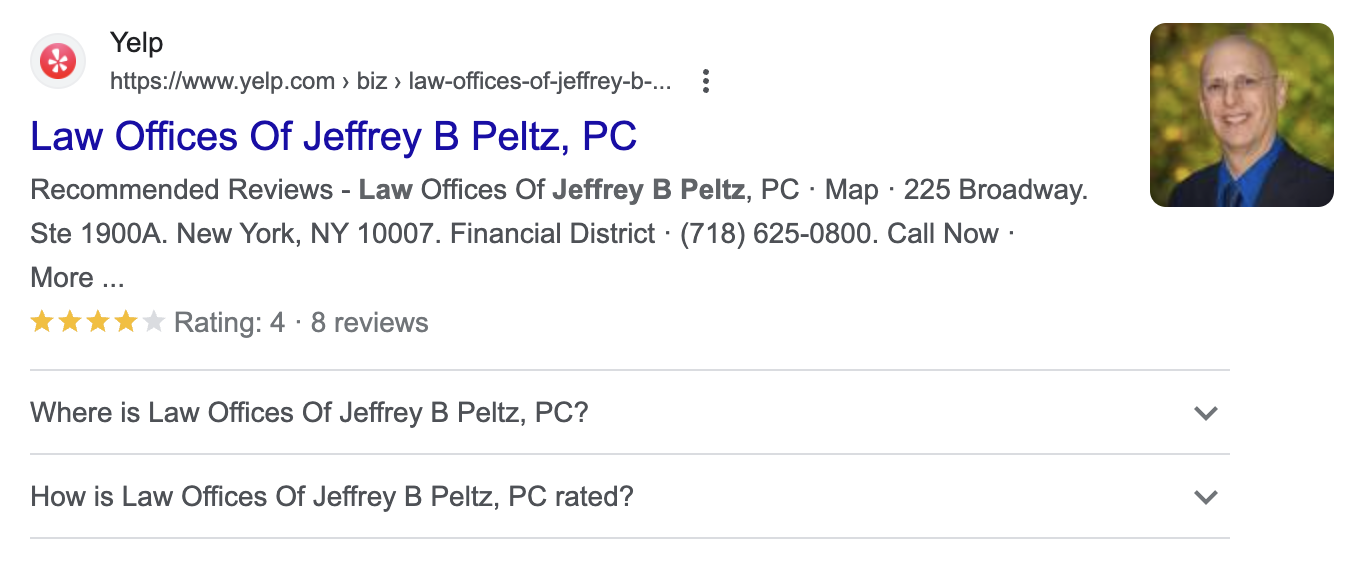
Why is all this important for your law firm? It’s all about visibility and click-through rates (CTRs). Enhanced listings take up more real estate on SERPs. As a result, your website is more noticeable.
Additionally, rich results provide users with immediate value and potentially increase the likelihood that they’ll click through to your site.
Implementing structured data involves adding the appropriate schema markup to your website’s HTML. It may sound complicated, but various tools and plugins can help simplify the process. Google’s Schema Markup Testing Tool, for instance, can help you validate your markup and ensure it’s correctly implemented.
And lastly, let’s talk about URL structure, one of the most important aspects of technical SEO. Have you ever found yourself lost in a new city because the street signs were confusing or non-existent? That’s how a user or search engine might feel when trying to navigate your website if your URLs are messy or unclear.
A good URL structure is akin to a clear, straightforward street sign; it guides users and search engines effortlessly through your website’s neighborhood.
URL, short for uniform resource locator, is the address of a webpage. URL structure refers to how these addresses are organized; the clearer and more readable, the better.
A clear, well-structured URL should ideally be readable. This means it should be concise and logically organized. It should also make sense to a human reader. For instance, www.yourlawfirm.com/family-law/divorce is far more readable than www.yourlawfirm.com/pg?id=123.
We also recommend sneaking keywords into your URL. This will help web users and search engines understand the content of the page. Using the previous example, the terms “family law” and “divorce” clearly indicate the topic of the page.
If your site has multiple pages or layers, the URL should follow a logical hierarchy. For instance, www.yourlawfirm.com/services/criminal-defense/dui indicates a clear path from services to criminal defense to DUI representation. In URL convention, hyphens are typically used to separate words (not underscores or spaces). This is because they’re recognized by search engines as word separators.
Ensure consistency across the board to keep both web users and search engines happy. Remember, URLs are a ranking factor. Ding, ding, ding! Search engines like Google use URL keywords to understand the content of a page and rank it higher (or lower) on Google SERPs accordingly.
A URL that reads www.yourlawfirm.com/family-law/divorce gives Google a clear context that the page is about divorce under the realm of family law. The outcome? Higher rankings for related search queries.
See how this works?
Play your cards well, and you’re in for terrific rankings. It’s all uphill from there: roaring traffic, neat conversions, and consistent law firm growth.
5. Create Valuable Content

Let’s play pretend. Imagine you’re not a lawyer for a moment but a client facing a legal challenge. You’re scared, confused, and seeking answers.
Now, you stumble upon two websites: one with generic, uninspiring content and another packed with insightful, clear, and expertly articulated information.
Which law firm will you trust your case to?
Exactly.
In the digital arena, your law firm isn’t just competing on legal expertise or client service; it’s also competing on content. The online content you create is the shining beacon that guides potential clients to your firm amidst a sea of legal offices.
It’s your ticket to transforming your firm from ‘just another office’ to ‘the legal authority’.
Let’s dive into how you can create valuable content that compels, convinces, and converts your target audience.
Your content portfolio should be a well-curated collection that demonstrates your breadth and depth of knowledge and caters to different stages of the client’s journey.
Instead of picking out content pieces at random, think strategically and smartly. Understand the different types of content popular among your audience and supply them in abundance. And develop a good grasp of the specific types of content that fail to resonate with your audience and toss them to the side accordingly.
Each content piece your law firm creates should serve a specific purpose and audience. Let’s explore the most popular and relevant content pieces for law firms.
Blogs
Blogs are the knights of your content chessboard: versatile, flexible, and capable of reaching places other pieces can’t. They serve multiple purposes: addressing frequently asked legal questions, discussing recent legal developments, or simply offering legal advice in a reader-friendly manner.
Blogs allow you to demonstrate your expertise in a less formal setting. When used correctly, this approach can help you make the law more accessible and your firm more approachable.
Write engaging, insightful, and value-added blogs that unpack complex legal topics. Sobo & Sobo is known for its comprehensive blogs that break legal complexities and intricacies down into bite-sized pieces.
Their blog titled “DUI, DWI & DWAI in New York: What’s the Difference?” is the perfect example of informative and digestible content.
Recommended Read: SEO Content Guide to Search Engine Ranking Factors
FAQs
FAQs are your pawns. They may seem small, but they’re mighty.
FAQs provide straightforward answers to common legal questions. This makes them an excellent resource for clients who are seeking quick information.
They also help improve your website’s SEO by targeting long-tail keywords. For instance, a potential client may Google “how to file for bankruptcy in New York,” a query you can directly address in your FAQs.
This is how your content will show up:
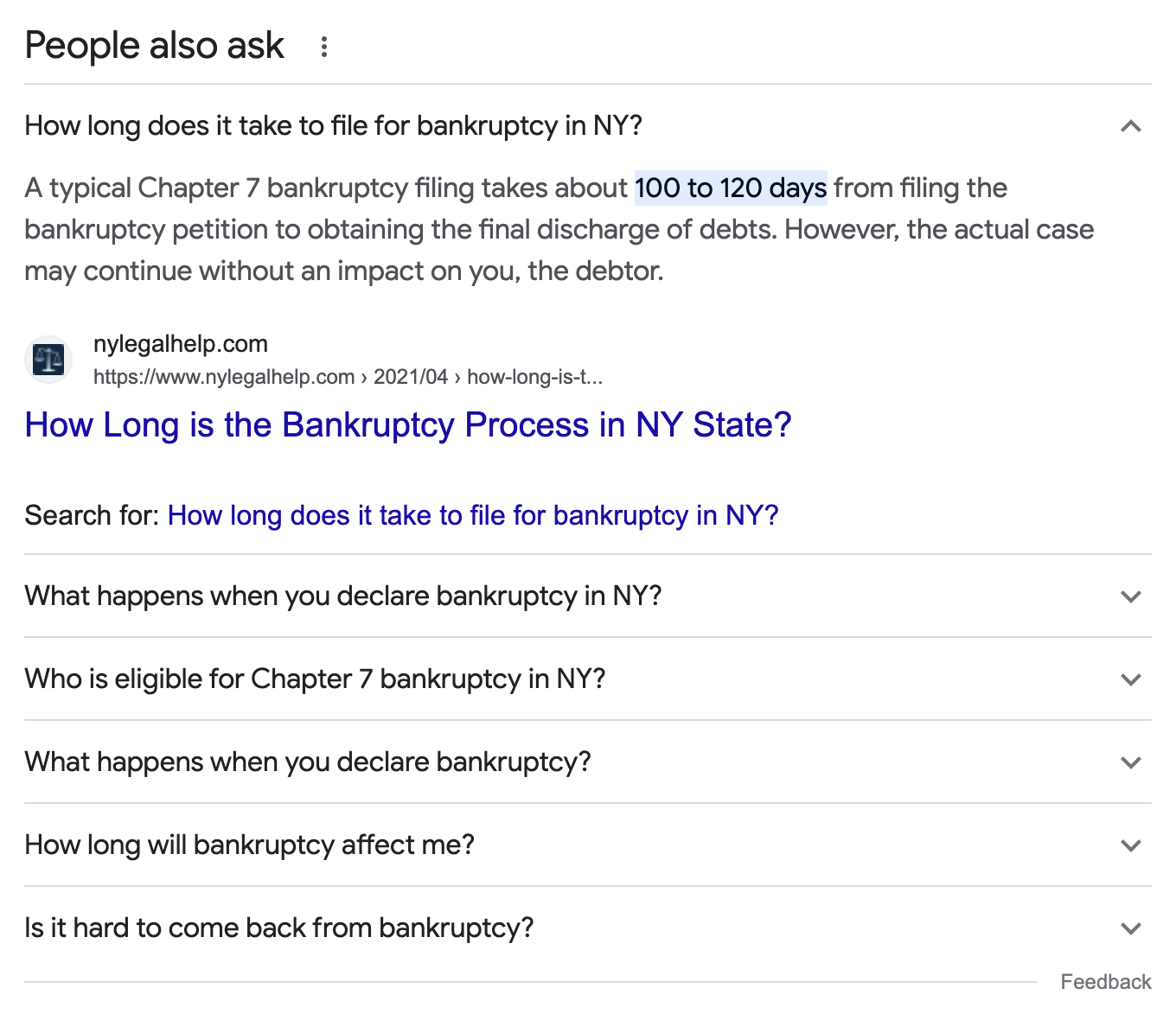
Sweet, right?
We also recommend creating a separate FAQs webpage. JL Carpenter’s FAQs page is a great example.

Cover as much ground as possible. Once web users land on your website’s FAQs page, they should be able to find answers to all their questions.
We recommend updating this page every two months to ensure comprehensiveness, accuracy, and relevance. You may have to update some answers based on the evolving legal landscape. And you may have to add new FAQs. Perhaps some of them need to be removed altogether!
Stay on top of your game to provide factual and updated information to your audience at all times.
eBooks and Whitepapers
eBooks and whitepapers are your rooks: strong and impactful. They allow you to delve deeper into complex topics and offer in-depth analysis that articles or blogs may not cover.
This detailed level of information can provide significant value to potential clients who are on the hunt for more substantial content.
Case Studies
Case studies are your queen: powerful and invaluable. By providing a real-life case that your firm handled successfully, you’re essentially providing a testament to your expertise and results.
This can be a game-changer for potential clients. It’ll help them understand how your firm handles cases, strategizes, and achieves positive outcomes.
Here’s how you could go about this:
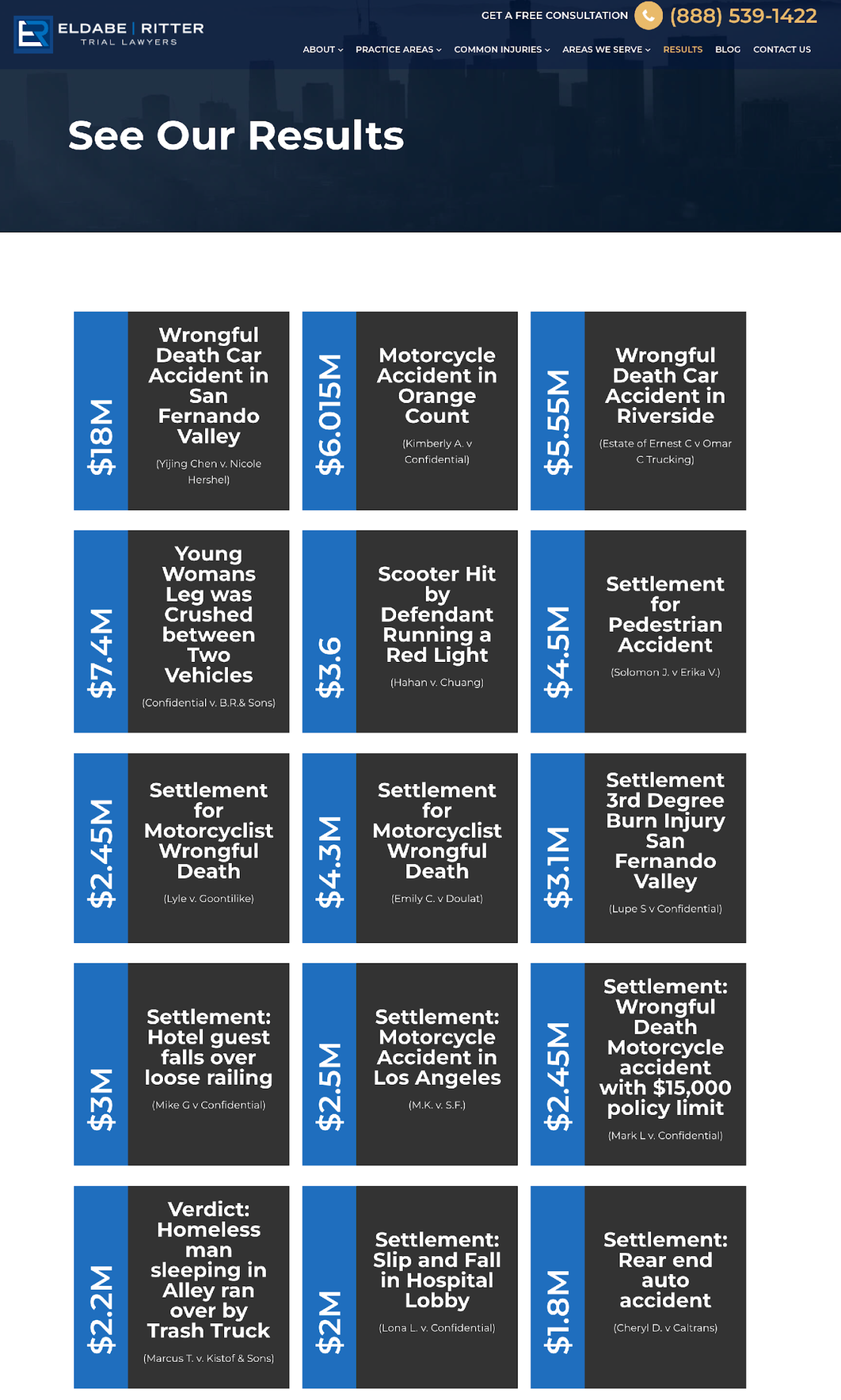
And if you want to get more creative, take a page out of Russell & Hill’s book. Their case studies are visually presented in one of the most unique, engaging, and aesthetically appealing ways we’ve ever seen!

See what we mean?
Instead of playing it safe, think outside the box and experiment with unique presentation styles. This little trick will go a long way in helping you keep your audience engaged and convert casual visitors into clients!
Videos
Videos are your bishops; they move differently and catch attention. In 2023, the vast majority of web users are visual learners; they prefer watching a video over reading lengthy text.
Videos can offer a more personal touch. Whether you put together an explainer video that breaks down complex legal procedures or create a testimonial video that features satisfied clients, the right video will help you inform and convert a wider audience.
Video content also significantly increases the time spent on a website. This sends a positive signal to search engines. The outcome? Fantastic SERP rankings.
Recommended Read: Video SEO: Optimize for Visual Intent and Video-First Searches
JL Carpenter’s website features a webpage dedicated to video content. This is an excellent way to walk your audience through legal topics in a more conversational, relaxed, and effortless manner.
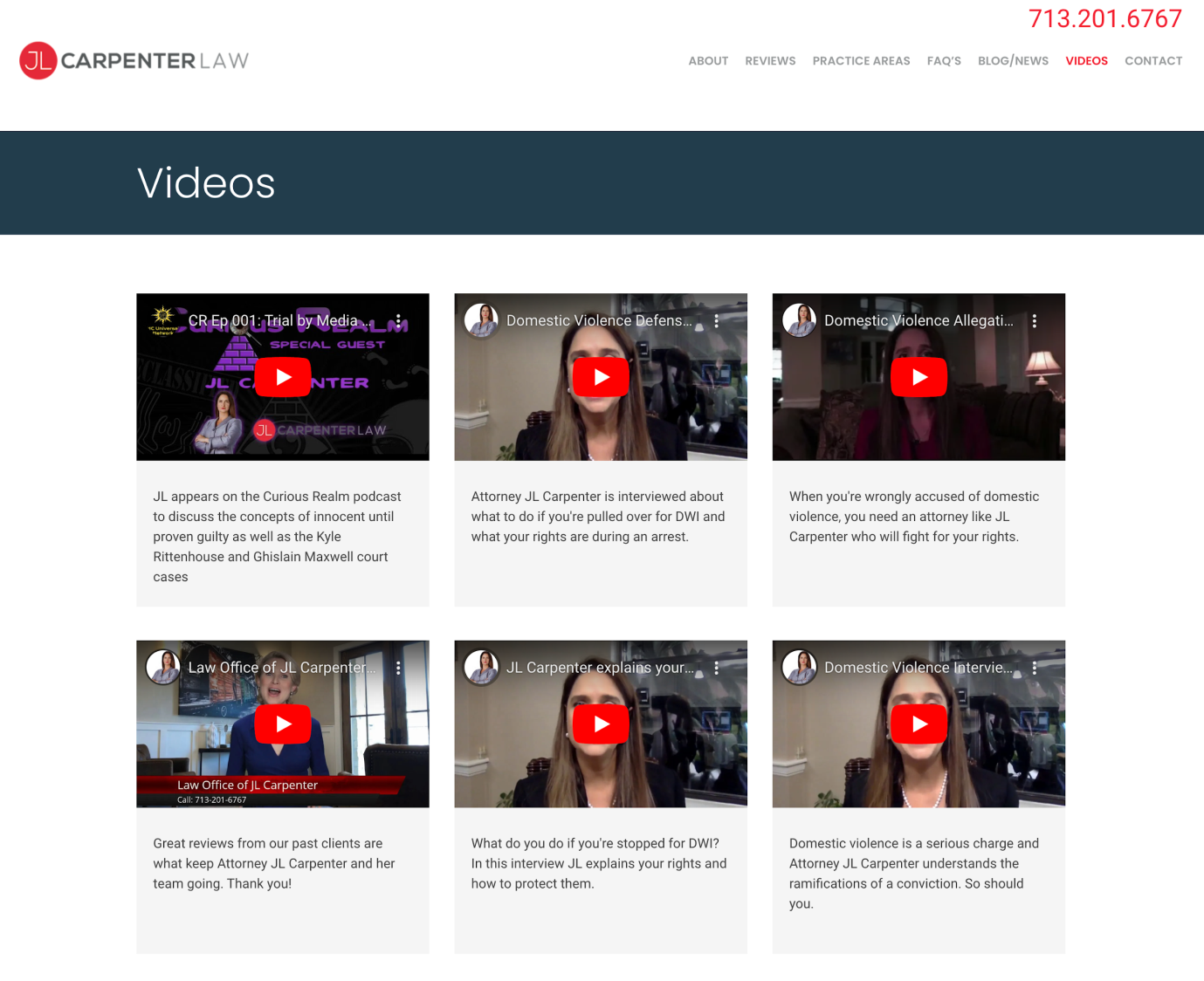
If you haven’t already, set up a YouTube channel. You can embed the videos on your website or upload them directly. At Search Berg, we offer professional video design services for lawyers. Walk us through your vision, and we’ll handle the rest!
6. Leverage Local SEO

Law firms no longer compete only on a city block or within court walls; they compete in the vast expanse of the online world. However, while global reach is a valuable asset, local presence holds the most importance for law firms.
After all, your clientele is predominantly local: people looking for legal representation in your city, neighborhood, and, sometimes, just around the corner. This is where local SEO enters the picture!
Local SEO is the process of fine-tuning your online presence to fetch more business from local queries on Google. As a law firm, this isn’t just a nice-to-have; it’s a must-have.
People who are on the hunt for lawyers typically look for professionals near them. Whether they’re facing a sudden legal issue or planning for a future need, they scan their vicinity for experienced lawyers who can build a strong case for them.
By leveraging local SEO, you’re ensuring that every time someone looks for “lawyers near me” or “lawyers in [your city]”, your law firm is the top result.
How can you pull this off?
Let’s show you the way.
Google Business Profile
Your law firm’s first point of contact with potential clients isn’t through your office door but rather your Google Business Profile (previously known as Google My Business). Think of this as a concise snapshot of your business on Google, complete with your firm’s name, location, operating hours, and reviews.
A Google Business Profile is an indispensable tool for local SEO. When someone searches for a law firm near them, Google often provides a list of local businesses in a box known as the Google Local 3-Pack. The Local Pack, in short, appears above organic search results.
Here’s what it looks like for the search query “best lawyers in NYC.”
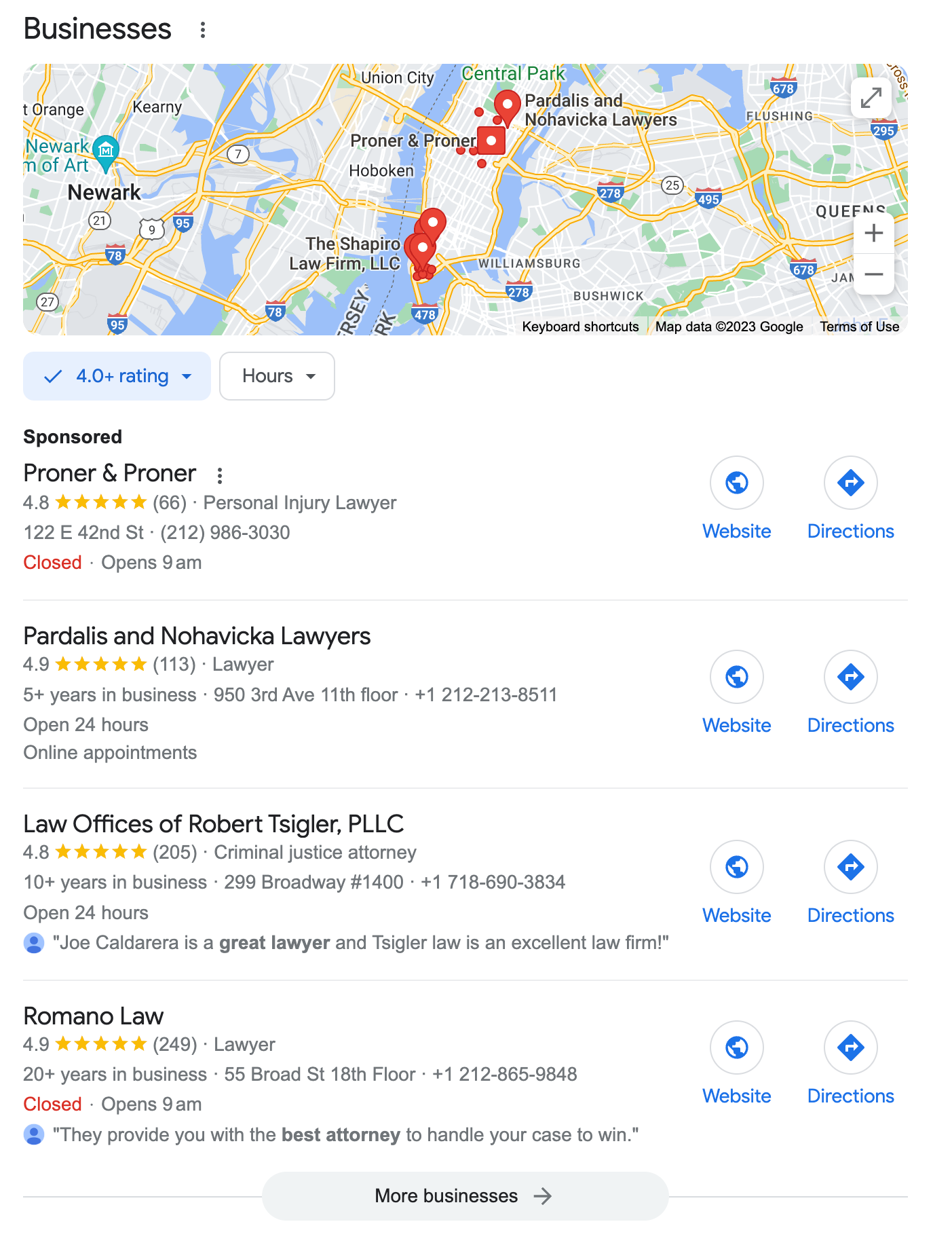
Catch our drift?
To make the most of your Google Business Profile (GBP), start by providing complete and accurate information about your law firm. This includes your firm’s name, address, phone number, website, and hours of operation. Google ranks complete profiles higher than incomplete ones.
All done? Categorize your business next. This helps Google decide which searches your listing is relevant to. Choose the category that best represents your law firm, e.g., “personal injury lawyer,” “divorce lawyer,” “criminal justice attorney,” and so on.
After setting up your GBP, you need to verify it. Google needs to confirm that your business is legitimate and that you’re authorized to manage the profile. Verification is pretty simple and straightforward; it can be done via postcard, phone, email, or Google Search Console.
Follow this up by filling in your GBP. Encourage your audience to leave reviews on your GBP. Positive reviews can significantly boost your GBP’s visibility.
Make sure you promptly respond to both positive and negative reviews. Google likes it when businesses interact with their customers. The more active you are, the better. This means Google will rank you higher in the Local Pack.
Keep filling your GBP with more content: updates, posts, photos, videos, virtual tours, and so on. Google allows you to post updates directly to your GBP; you can share news, promotions, events, or even legal advice.
Make sure you post high-quality, engaging, and enriching content that resonates with your audience.
Pardalis & Nohavicka is known for sharing high-resolution photos of their firm, team, and cases. Here’s a glimpse:

Similarly, Romano Law stands out for its frequent GBP updates.

And Antin, Ehrlich & Epstein steals the show by actively and gratuitously responding to customer reviews.
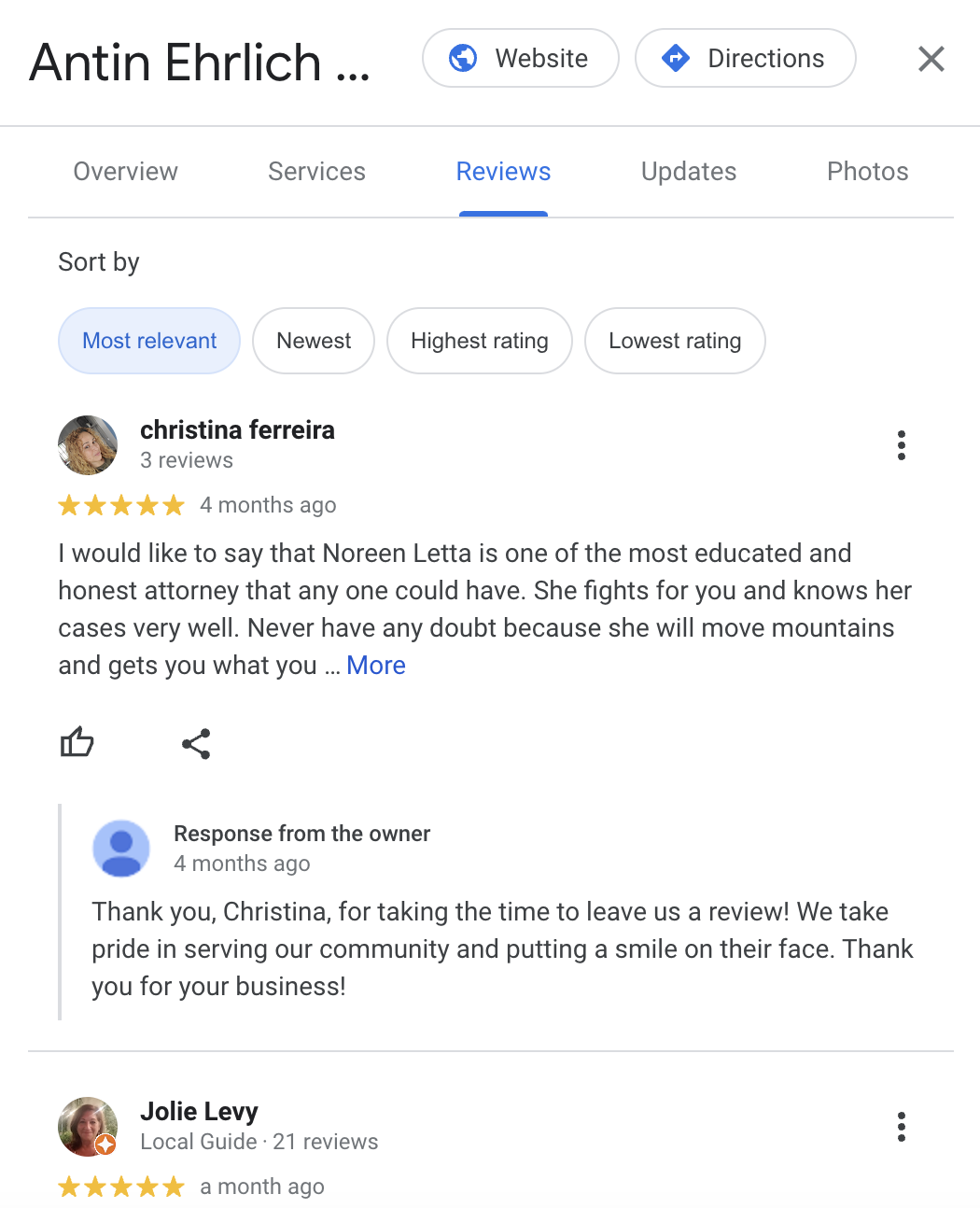
The more thought, attention, and care you pour into your GBP, the higher your SERP rankings. Google plays by the rules; it rewards law firms that provide quality content and a seamless experience to web users.
When you give Google what it wants, it’ll certainly return the favor.
If you’re having trouble with local SEO, work with a marketing agency for lawyers. They’ll dissect your current local SEO performance and craft a power-packed campaign accordingly.
While local SEO is essential for all law firms, it’s an especially integral part of small law firm marketing. If you’re just getting started and building traction, invest in local SEO to earn a much-needed boost in online visibility.
Online Directories
Long gone are the days when people would thumb through a physical directory to find a law firm. In 2023, online directories have taken the mantle. They’re essentially the modern version of Yellow Pages, only far more comprehensive, interactive, and accessible.
Online directories are a vital element of a well-rounded SEO strategy for your law firm. They offer a centralized platform for potential clients to discover, learn about, and contact your law firm. A robust presence across these directories can increase your online visibility, boost your local SEO, and improve your credibility.
Not all online directories are created equal. Some are more reputable and generate more traffic than others. Take some time to do your research and select the right directories.
Here are our top picks:
Domain Authority: 52
Domain Authority: 94
Domain Authority: 71
Domain Authority: 88
Domain Authority: 71
Domain Authority: 63
Domain Authority: 60
Domain Authority: 85
Domain Authority: 46
Domain Authority: 66
Domain Authority: 58
Domain Authority: 46
Domain Authority: 64
Domain Authority: 71
Domain Authority: 91
Domain Authority: 60
Domain Authority: 92
Domain Authority: 91
Domain Authority: 58
Keep in mind that while a higher domain authority score is generally better, it’s also important to focus on directories that are relevant and popular among your target audience.
This is where directory research becomes non-negotiable. Work with a legal marketing firm to identify the best listings for your law firm and audience.
When listing your law firm on various directories, maintain consistent information across all platforms, especially concerning your firm’s name, address, and phone number (NAP). Inconsistent information can confuse search engines and hurt your local SEO efforts.
Just like with your Google Business Profile, ensure that your directory profiles are as complete and detailed as possible. The more information you provide, the easier it’ll be for potential clients to understand what your firm offers and how you can assist them.
7. Use Social Media

If you’re not leveraging the power of social media for your law firm, you’re missing out on a goldmine of potential clients; no exaggeration.
Social media is no longer a place where people just share their daily activities or cat videos (although we love those). In 2023, it has evolved into a powerful marketing platform that can substantially boost your law firm’s online visibility and reputation.
Just consider this. 4.9 billion people use social media regularly worldwide. That’s not an ordinary number. Let it hit you again: 4.9 billion people.
This means that your prospective clients are already hanging out on these platforms. By building a robust social media presence, you’re not only reaching them where they already are, but you’re also showing them a more relatable and engaging side of your law firm!
Start by choosing the right platforms. Not every social media platform is suitable for every business. For law firms, LinkedIn, Facebook, Twitter, and Instagram are usually the most relevant platforms.
LinkedIn is excellent for networking with other professionals and demonstrating your expertise, while Facebook, Twitter, and Instagram are great for engaging with your clients directly.
Since your social media profile is the digital face of your law firm, make sure it’s professional, comprehensive, and reflective of your brand’s identity. Use a high-resolution logo, write a compelling bio, and include a link to your website.
All done?
It’s time to get to work!
Your social media profile is only as good as the content you share. Instead of casually churning out run-of-the-mill content, be intentional with the process.
Share valuable content that informs and engages your audience. This is a great time to revisit the target audience insights you collected earlier. Carefully review your audience’s legal requirements, pain points, and interests.
What are the common legal questions they have? Which topics are they most likely to engage with? Answer these questions to determine a good grasp of the kind of social media content you should create.
Variety is key here; don’t limit yourself to a single type of content. Experiment with different formats to cater to diverse preferences.
Pardalis & Nohavicka is known for sharing engaging, diverse, and thought-provoking posts and stories. Their latest Instagram post is a slice of the perfect social media marketing pie for lawyers.
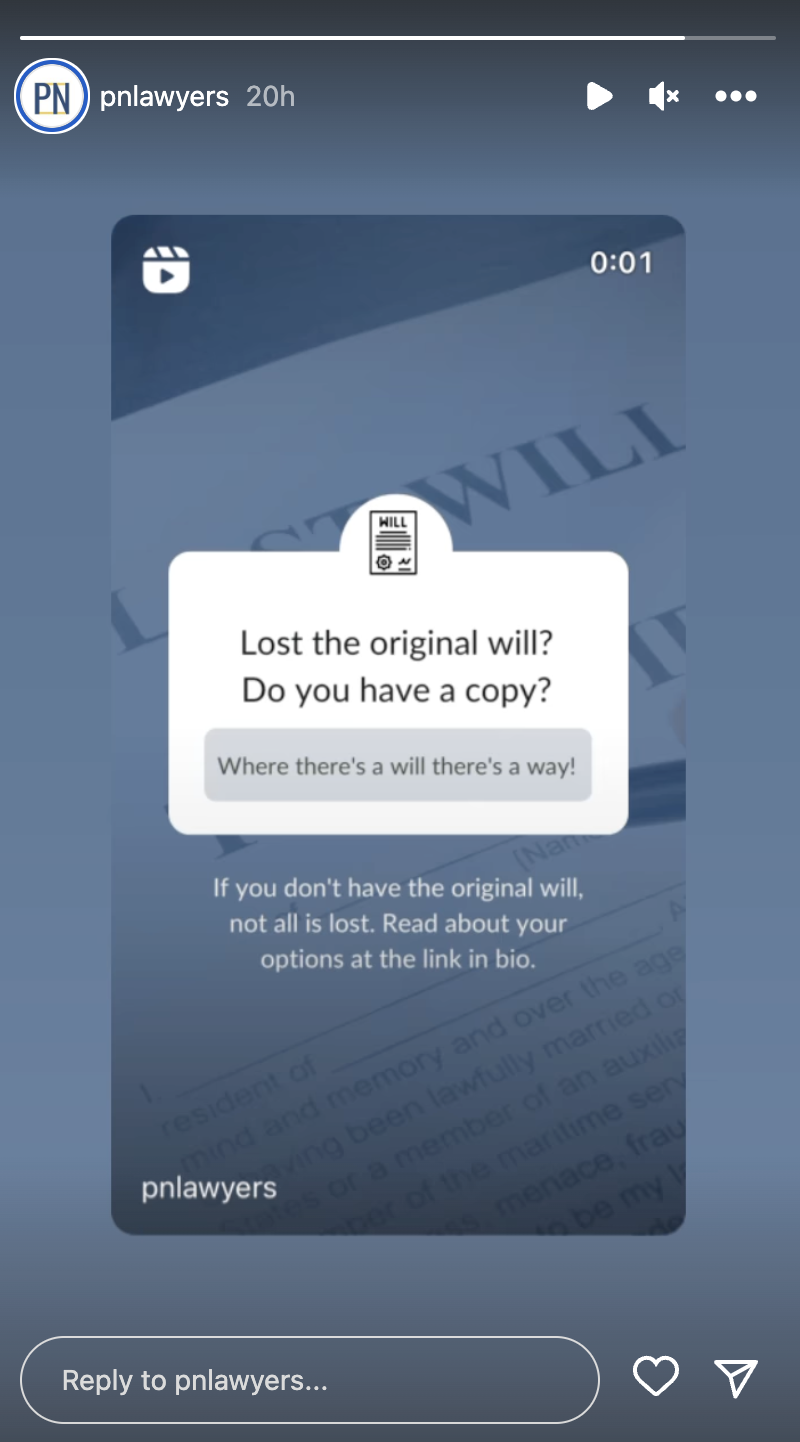
See what we mean?
They frequently share legal tips, polls, FAQs, surveys, legal news, updates, behind-the-scenes content, testimonials, live Q&A sessions, industry insights, and so much more. This is the perfect place to get creative! The more engaging and exciting your content, the better.
Your social media content should aim to educate and empower your audience. Instead of using a lot of legal jargon, simplify complex legal topics. Empowering your audience with palatable knowledge is an excellent way to build trust and position yourself as a valuable resource.
In 2023, user-generated content (UGC) is a treasure trove for your law firm’s social media strategy. UGC is any content created and shared by your clients, followers, or community members that showcases their experiences, testimonials, or interactions with your firm.
It’s a powerful tool that allows you to amplify your brand message, build trust, and foster a sense of community around your law firm.
Highlight real-life success stories from your clients. Ask them to share how your firm helped them overcome legal challenges, achieve favorable outcomes, and regain peace of mind. Share these stories on social media to demonstrate your firm’s expertise and the positive impact you’ve made in people’s lives!
Recommended Read: Social Media and SEO: How to Use Social Media to Improve SEO Rankings
8. Try Your Hand at Pay-Per-Click Advertising

In a profession where outcomes are uncertain, and courtrooms are filled with suspense, it’s refreshing to have a marketing strategy that delivers guaranteed results.
Pay-per-click (PPC) advertising is the surety you’ve been looking for. Unlike traditional advertising methods, PPC allows you to specifically target individuals who are actively looking for legal services online.
Here’s how it works.
It all starts with identifying high-ranking keywords that potential clients are typing into search engines when looking for legal assistance. As a law firm, you bid on these keywords and compete with other firms to grab the top SERP spots.
Once you’ve chosen your keywords, it’s time to weave spellbinding copy. Craft captivating ads that highlight your law firm’s unique selling points, expertise, and services. The goal is to use concise and persuasive language that entices potential clients to click on your ads and discover the magic you have to offer.
PPC advertising gives you the power to control your spending. Set a budget that aligns with your firm’s goals. The great thing about PPC advertising is that you don’t have to go overboard; you can stick to your budget through and through.
Simply determine how much you’re willing to bid for each click and the overall amount you’re willing to invest in your PPC campaigns. Once this amount is set, it’ll remain constant until you decide to tweak your campaign.
The sorcery of PPC lies in its ability to precisely target your desired audience. You can define your audience based on specific factors like location, demographics, search intent, and even the time of day. This ensures that your ads are seen by the right people at the right time.
Since you only pay when someone clicks on your ad, you’re not wasting your budget on impressions alone; you’re investing in actual engagement and potential leads. This cost-effective approach allows you to allocate your resources strategically and track the return on your investment.
Since PPC advertising is a complex marketing technique, it’s best left to experts. Instead of taking the reins yourself, work with an experienced legal marketing firm that takes care of all the legwork for you.
When executed to perfection, your PPC advertising strategy can put your law firm in the spotlight and help you gain a competitive edge in the digital landscape.
Recommended Read: PPC Management for Small Businesses: Tips and Tricks
Let Search Berg Show You the Way!
In this blog, we walked you through the A–Z of law firm marketing. Now that the game plan is laid out in front of you, it’s time to make full use of it!
Search Berg is here to show you the way.
As one of the leading legal marketing firms in 2023, we specialize in helping up-and-coming law firms get seen by their target audience online. Our goal is to ensure that your phone starts ringing, your meeting rooms buzz with consultations, and the courtroom is filled with the sound of your victory.
Sounds like a plan?
Explore our SEO services for lawyers to get started!
Whether you’re interested in small law firm marketing or looking for law firm marketing ideas for established firms, we’ll take the reins and steer your business in the right direction.
As an experienced, established, and reputable marketing agency for lawyers, we don’t drop the ball; that’s a promise.
For more information about our legal marketing services, give us a call today. It’s time to pull your firm to the top SERPs and fetch a roaring round of applause (and revenue) from clients.














